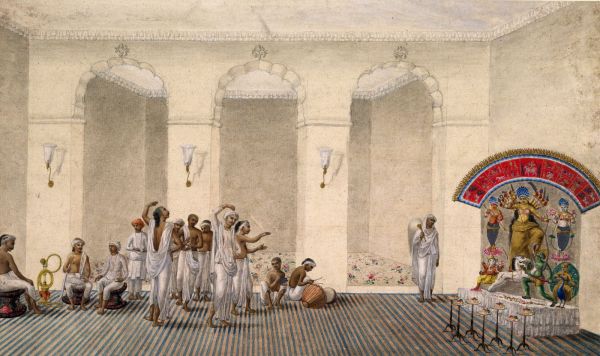DURGA PUJA
1. Context
As the oppressive heat of the Indian summer gives way to the gentle chill of autumn, an air of excitement covers Bengal, and eastern India. It is time for Goddess Durga’s homecoming, celebrated by Bengalis as Durga Puja — as much a religious occasion as one for frivolous merrymaking.
2.Robert Clive and Durga Puja
- Durga Puja has many apocryphal origin stories. The most popular is set in the aftermath of the Battle of Plassey, in 1757.
- By defeating Nawab Siraj ud Daula, Robert Clive changed the course of Indian history, cementing East India Company’s hold over Bengal, and eventually, the whole subcontinent. The victory also made Clive a very rich man
- The deeply religious Clive credited God for unbelievable fortune, and wanted to hold a grand ceremony in Calcutta to convey his thanks
- The former Nawab, however, had razed the only church in the nascent city. So in stepped Nabakishan Deb, Clive’s Persian translator and close confidante.
- Deb told Clive to come to his mansion instead, and make offerings to Goddess Durga thus began Calcutta’s first Durga Puja.
- Deb’s mansion in Sovabazar, preserved today by West Bengal tourism, still hosts what is colloquially known as “Company Puja”.
- Yet, this story does not pass muster. There is no record of Deb knowing Clive, let alone being a close confidante, prior to 1757.
- There is also no evidence of the Puja actually taking place that year, except for an anonymous painting. While the Sovabazar Puja is undoubtedly among the oldest in Calcutta, its origin story is highly suspect.
- Nonetheless, the story serves as a metaphor for the sociological origins of Durga Puja in Calcutta. Put simply, the origins of modern Durga Puja can be credited to the nexus between Bengali zamindars and merchants, and the East India Company

3. Durga Puja as a Status Symbol
- With Company rule in Bengal came a host of social and economic changes. Most notable, in the story of Durga Puja, was the rise of a new class of powerful natives who reaped the benefits of Company rule.
- First were zamindars, or hereditary landowners. After the decline of the centralised Mughal state, zamindars in Bengal had become increasingly assertive, effectively running their own fiefdoms.
- The Company effectively treated them as intermediaries between themself and the native population, with the Permanent Settlement Act of 1793 solidifying their position
- Then there was the emergent class of rich Bengali merchants, especially in the fast-growing urban centre of Calcutta.
- With Company rule came economic opportunity at a scale not seen before some people got very rich, very quickly. Thus emerged big mercantile families such as the Tagores or the Mullick

4. Durga Puja and Nationalism
- By the late 19th century, feelings of nationalism emerged in the Bengali population, especially the educated intelligentsia.
- Bankim’s Ananda Math was published in 1882. A fictionalised version of the late 18th century Sanyasi Rebellion, the novel popularised the phrase “Bande Mataram” putting into popular consciousness the imagination of the “nation” as the “mother”.
- Goddess Durga, worshipped as “Ma” (or mother) Durga, thus became the ultimate embodiment of the nation, as well as the figure who would act as its saviour from foreign rule. Durga Pujas were suddenly a part of the nascent nationalist project.
- This meaning became particularly pronounced after Lord Curzon’s decision to Partition Bengal in 1905.
- ‘Bande Mataram’ became the battle cry of the ensuing Swadeshi Movement, considered to be the first mass movement of the Indian freedom struggle, communal festivities became places where collective consciousness and action was forged.
- At the Pujas themselves, British elites were far less welcome than before. “One British officer reported that he had seen an image of Durga where the buffalo demon had been replaced by one of his colleagues,”
5. Way forward
In the 1920s, public Pujas began to emerge — from being a festival of wealthy Bengali elites, Puja started to become a festival for everyone. According to McDermott, this was both an outcome of Gandhian rhetoric against untouchability as well the need for Hindu consolidation.
The first sarbojanin, or “universal,” Puja was organised in 1926, in Maniktala in Calcutta
Source: indianexpress




